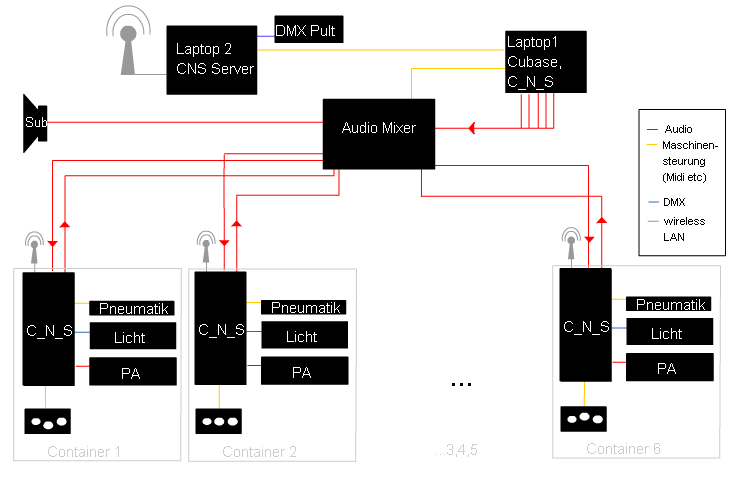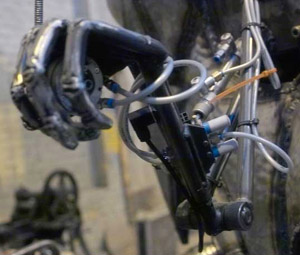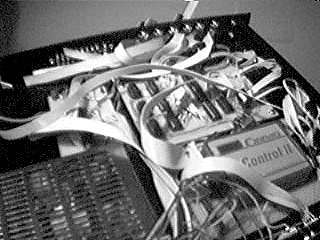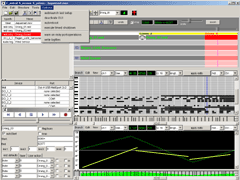| ChiMech - How it works | ||||||||||||||||||
| With the engagement for Lille2004 and the subsequent transformation of the Monstercabinet into a mobile interactive machine art and monster exhibition we have also consequently reworked the technical infrastructure and the control system behind the monsters. Today each of the ChiMech containers is an autonomous unit, that needs nothing but a 32Amperes three phase power connection to be operatable in public space. Onboard each container is a compressor with air conditioning system, a soundsystem, suitable to serve app. 100 people in front of the unit and a PC based controlsystem, that plays our music tracks, moves the machines in sync and handles the longer term running of the installation according to audience input on the control panels, time and other parameters. Connected to the PCs (1300mHz Durons, the cheapest complete system we could get in 2004), are custom digital analogue interfaces of various types and sizes (RS232 serial, Midi and parallel, 24 - 72 output channels). These translate the serial data stream from the computers into parallel events
Beside these pneumatics drivers the computers also control a crude mixture of light dimmers (analoque, Midi and - upcoming - DMX). Every Container is also equipped with an audience control panel, that presents 4 heavy duty industrial pushbuttons and 2 LEDs to the audience. These panels, mounted on the outside of the containers, are connected to the PCs parallel ports and are read out in an dynamically changing manner by the software, giving basic feedback (green - accepting input, red - busy, flashing red - machine part busy) via the LEDs. The Jaquemart of course has no audience control, but runs timercontrolled only The software running ChiMech is called C_N_S - for Central Nervous System - I wrote it during 2003. It is a bastard of classic Audio/Midi sequencing software as Cubase or Logic, media control systems like Trax or Medialon and classic SPS Software. C_N_S is entirely written in Java and uses some Quicktime4Java on the media handling side. It has a number of separate sequencing layers. One that is active during music playback is like known from classic MidiSequencers - it spits out time ordered events, layed out in a classical music score - synchronized to audio playback. In oposition to standard midi sequencers C_N_S will play these events not only to midi ports but realtime transform them to any device's format the software
The second sequencing layer works on longer terms. On a C_N_S project's timeline there are multiple scenes, which may represent both different songs as well as periods in which the machine reacts upon user input. A concept of scene-jumping and linking now constantly moves the installation into different stages. After a song is played, C_N_S will start reading the audience buttons, both counting button presses, time between inputs (frequency, intensity...) and time in general. According to audience activity, C_N_S will switch to follow up scenes with higher intensity of machine movements or reset counters and/or go to more relaxed scenes. In these audience control scenes a third sequencing layer, that I call Sequence Sampler, becomes active. It offers the possibility to trigger entire audio/midi sequences by a single button event and is used for example to make the seperate heads of the Seelenchor give their short speech & motion statements. The Sequenece Sampler plays up to 16 sequences in parallel, optionally synchronizing them to a common clock. Usually the four buttons on the audience's control panels are mapped to groups of sequences for separate parts of the machine. When a button is pressed the software will randomly pick one out of the button-corresponding group, wait for the next quarter beat when other sequences are running and then start the audiosample and midi playback. When samples out of all four groups have been triggered, the red LED will go on and no more input is accepted until one of the playing sequences has finished. When a button is pressed whose corresponding sample group is currently active, the red LED will flash, the audience will have to try a different button then. When certain conditions have been reached, i.e. the audience has pushed the container to a relatively high level of activity, the machine will take control out of the audiences hand and start acting on itself, i.e playing a song before going back to audience control etc. The same will happen when no audience is there at all. The machine will in longer intervals of app. half an hour just play a song to attract whoever passes by. The whole game is somehow right in the middle between truely interactive and totally enigmatic. As there are a lot of soft parameters involved in the process, one may guess roughly about the intensity level of the following stage, but
The system is operating pretty stable. We lost one computer by a serious hardware fault right before the opening in Lille and had to run the vernisage from my laptop, but for the rest of the time it mostly worked fine. Some minor problems like RAM bricks vibrated loose during transport, an overloaded, as initially undersized - driver power supply and other minor misfortunes, but beside that it all bravely survived and served the approximately 250000 people that pushed buttons during Lille2004. For 'Zukunftsmusik' the software has been further extended. C_N_S is now accompanied by a server program, that receives Midi from a central sequencer, transforms it into a C_N_S custom format and distributes it to all ChiMech containers via a wireless network. The server also includes a scene programable light desk whose data is also network transferred and retranslated to DMX on the client containers and remote control facilities for the C_N_S clients. 'Zukunftsmusik' will run as a distributed system: At times all data will come from the central sequencer, at times the connected containers will act on themselves. The same is true for audio: music and voices will partly come from the central instance and partly be played back by the single containers Pcs. These PCs also act as audiomixers, mixing their own wave playback with signals fed into line in. That way the separate units' sound appliances are combined into a fancy surround system. Here is a blockdiagram, illustrating the principle. |
||||||||||||||||||
 |
||||||||||||||||||
| To come to an end, let me say that C_N_S is available free of charge to other artists if an (uncommercial) project I'm presented with, sounds interesting to me. Just contact us for details. deadchickens, np+=5 back to ChiMech |


